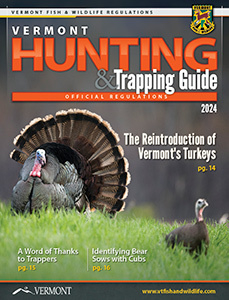Chronic Wasting Disease (CWD)
What if Chronic Wasting Disease Makes it to Vermont?
Chronic Wasting Disease (CWD) is a contagious, always-fatal disease that affects members of the deer family, including white-tailed deer, mule deer, elk, and moose. The disease continues to spread in North America and has been found in 32 US states and 4 Canadian provinces. There are no treatments or vaccines for CWD.
If CWD is detected in Vermont, the Fish and Wildlife Department will act quickly to attempt to contain it. This will involve dramatically reducing deer numbers in the area where CWD was detected. Ideally, this would remove all infected deer and limit the number of healthy deer exposed to the potentially contaminated environment. The prions that cause CWD can remain in the soil for a long time and can cause CWD in deer for a decade or longer. It’s impossible to predict the outcome for Vermont’s deer herd if CWD enters the state.
If initial attempts to contain the disease are unsuccessful and CWD becomes established in Vermont, the deer population, deer management and deer hunting will never be the same. Because CWD is slow to spread and can take several years to kill an infected deer, the initial impacts will not be obvious. Deer will be infected, and deer will die. Most areas that currently have CWD haven’t had it long enough to see the full effects of the disease.
Over time, more and more deer will be infected each year, and more deer will die. When enough do become infected and die, deer numbers will begin to irreversibly decline. In areas where CWD has been present for about 20 years, about half of all mature bucks are now infected and deer numbers are expected to decline. It is not clear if infected populations will eventually die out, but there is currently no evidence that the declines will stop.
While the long-term effects of CWD are a serious concern, the situation is not hopeless. Scientists learn more about this disease every day, and that knowledge may eventually lead to solutions. But we need to stop it from spreading further. The most effective way to control CWD is to prevent it from getting here in the first place.
How You Can Help
- Report sick-looking deer to the Vermont Fish and Wildlife Department by calling 802-828-1000.
- Learn about CWD and how it spreads.
- If you hunt in another state, follow rules restricting carcass importation.
- Do not use natural deer urine lures.
- Encourage your friends to follow the rules.
Urine Lures
It is illegal to use deer urine lures. They present a serious threat of introducing CWD to Vermont. CWD infectious prions can be present in deer urine lures. Use synthetic alternatives instead.
States with CWD
The Following States & Provinces Have or Have Had CWD
States: Alabama, Arkansas, Colorado, Florida, Idaho, Illinois, Iowa, Kansas, Louisiana, Maryland, Michigan, Minnesota, Mississippi, Missouri, Montana, Nebraska, New Mexico, New York, North Carolina, North Dakota, Ohio, Oklahoma, Pennsylvania, South Dakota, Tennessee, Texas, Utah, Virginia, West Virginia, Wisconsin, Wyoming
Provinces: Alberta, Quebec, Manitoba, Saskatchewan
Others may be added throughout the year.
Importation
Restrictions apply for the importation of deer or elk carcasses or parts from states or provinces that have, or have had, CWD. To date, the disease has been documented in 30 states and 4 Canadian provinces including New York State. New Hampshire, Maine and Massachusetts have not documented CWD. Quebec has recently confirmed CWD in a captive red deer facility and is now on the list of states and provinces from which it is illegal to import deer carcasses or parts. It is illegal to import deer or moose carcasses or parts from New York, Quebec, and all other states and provinces on the list. See Importing under the Big Game section for details.

